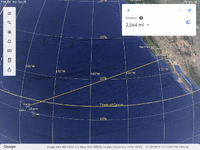A paper napkin approximation, sans calculus.
1. Sketch a circle and put two points L and H approximately proportional to the La to Hawaii distance.
2. Sketch a radius from the center of the Earth to each point labeled r, label the angle phi.
3. Sketch a straight line from L to H, a chord.
4. Sketch a radius from the circle center through the midpoint of the chord.
5 label one half the chord x
6. Label the radius segment from the midpoint to the circle as d
6. Label he radius segment form the midpoint to the center as y.
7. A circle is 360 degrees, phi = (360 degrees)*(distance from L to H on circle )/(circumference of the circle)
8. Two right tangles are formed. Angles are 90 , 90-phi/2,and phi/2 degrees. Find x,y, and d and d max depth.
Python
import math
maxoceadepth = 6 # km
r = 6378 # Earth radiu km
edensity = 5515 # kg/m3
dla2hon = 4119 #km La to Honolulu
ecirc = math.pi*2*r # Earth circumference
phi = 2. * math.pi * (dla2hon/ecirc) # angle in radians
x = r * math.sin(phi/2.)
dtunnel = x * 2.
y = r * math.cos(phi/2.)
depth = r - y
tunpasc = 1e9*depth/30. # change in prssure
tunpsi = tunpasc*6894.76
T = (dtunnel*.5 ) - 273
print("Marianas Trench Pressure Pascals 1e+8 PSI %.1e" %(1e8/6894.76))
print("Tunnel Pressure Pascals %.1e PSI %.1e" %(tunpasc,tunpsi))
print("Distance La Honolulu %.1f km %.1f miles" %(dla2hon,dla2hon*0.621371))
print("Max Depth %.1f km %.1f miles" %(depth,depth*0.621371))
print("Tunnel Length %.1f km %.1f miles" %(dtunnel,dtunnel*0.621371))
print("Temperature Rise %.1f C\n" %T)
Marianas Trench Pressure Pascals 1e+8 PSI 1.5e+04
Tunnel Pressure Pascals 1.1e+10 PSI 7.6e+13
Distance La Honolulu 4119.0 km 2559.4 miles
Max Depth 329.6 km 204.8 miles
Tunnel Length 4047.8 km 2515.2 miles
Temperature Rise 1750.9 C
Submersibles have been to the bottom of the Marianas Trench.
There are several approximations for temperature rise and pressure rise. It would take some reading to get to the basis for he approximations, taken with a grain of salt. It is hard for me to read the low resolution plots.
What is the geothermal gradient in the mantle?
Geothermal gradient - Wikipedia
Thus, the geothermal gradient within the bulk of Earth's mantle is of the order of 0.5 kelvin per kilometer, and is determined by the adiabatic gradient associated with mantle material (peridotite in the upper mantle).
The gigapascal is the conventional unit of pressure when discussing the deep earth. From the surface to the transition zone - lower mantle boundary (670 km depth) we can estimate the pressure by the simple rule of thumb that each 30 km depth change is close to 1 GPa pressure change.


